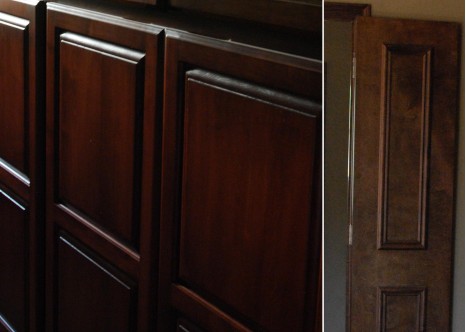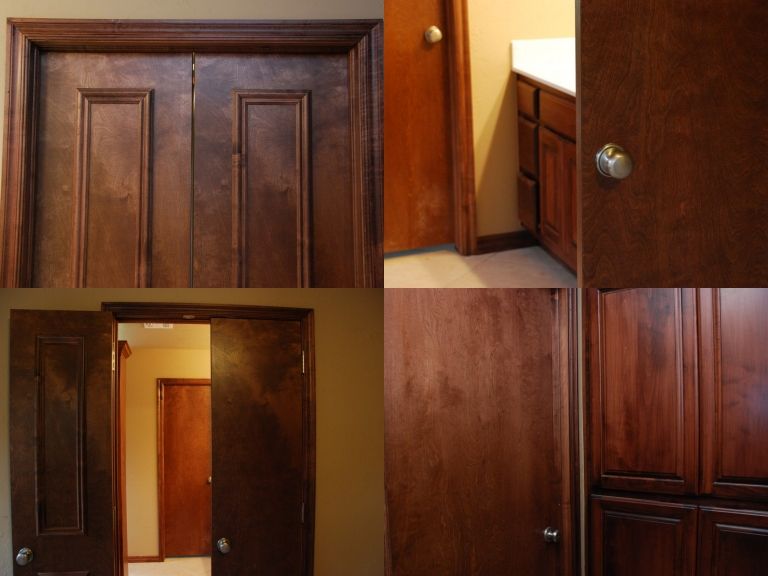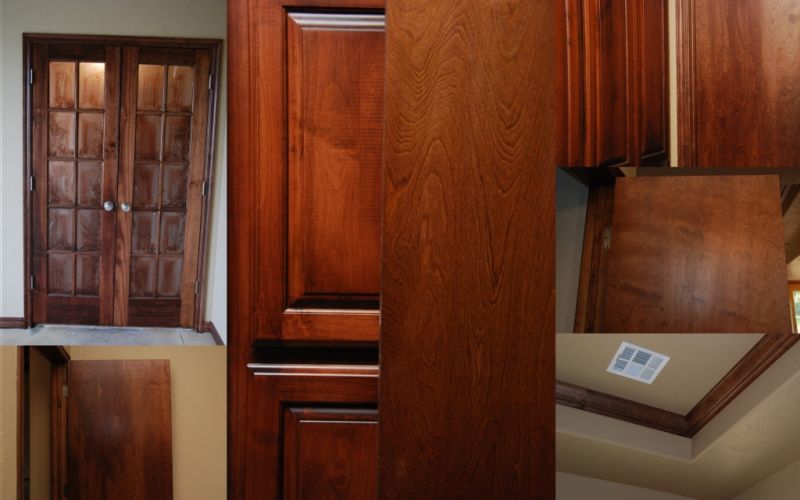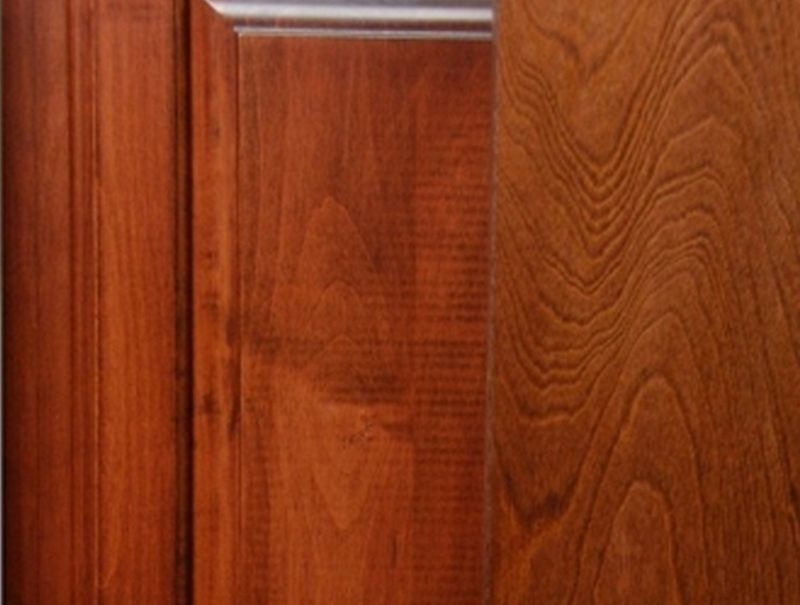Troubleshooting a Poor Stain Match
Finishers discuss what could have created a glaring mismatch between Maple and Birch components supposedly stained with the same formula. August 6, 2010
Question
New cabinets, doors, moldings, etc. were stained professionally for a cherry finish, but they look way different. As shown in the picture, the solid maple cabinets are fine, but the birch veneer doors are very much brown, along with most of the solid maple moldings and sills. We're told everything was done properly. I don't want to argue, but the differences in finish are too great for me to accept. Any thoughts on what happened or what I should do?

Click here for higher quality, full size image
Forum Responses
(Finishing Forum)
From contributor G:
Was that using the same stain and done at the same time?
From the original questioner:
They weren't all stained exactly at the same time, but all staining was completed within two weeks. We were told at the beginning that the same stain would be used on everything and would result in a similar finish. The door shown has the brownest appearance and it was one of the last to be stained due to other work that had to be done beforehand in that room. It seems like the earlier staining had the best results.
From contributor J:
An old finisher (my father) once told me, "If you want everything to come out the same color, don't stain it... paint it."
Different woods accept stain differently, to the point where getting close to the same color on different woods or even on different pieces of the same type of wood may require not only different techniques, but possibly different stains and processes as well. Maple and birch should be doable, but may require the use of dyes or toners to get acceptable results. Keep in mind that even if a perfect color match between the two woods is achieved, the grain will still look different.
Did the finisher provide samples of the color on both woods for you to approve before starting the job? If not, then you have a case of their definition of "similar finish" being different than yours.
It looks like the birch doors could be toned to bring them closer to the cabinets, but this would mean having them removed and resprayed or brushed on site with a polyshades type finish. In either case, I would consider seeking the services of a better finisher.
From contributor H:
Of course they will be different. The woods are different. The birch, in this case, would require additional staining with a different stain or colored finish to match the cherry more closely. You could remove the applied molding and veneer the faces with cherry and then re-stain.
From contributor R:
The finish in question might have been applied properly and you probably won't get anywhere by arguing. Yes, the color is different from one wood to the other. If you won't accept (sign off) the end results, I see only one option for you, and that's to refuse paying whatever balance is due.
Did you sign off on the color samples that the finisher prepared for you? Were two different color samples provided, one on maple and the other on birch? Did those two samples match in color? Did the finisher explain that since you were using two different woods, you might end up with two different colors? Why was some of the woodwork done in birch when the majority of the project was maple?
It's been my experience that a qualified finisher should be able to match colors and have the knowledge to achieve an even color match on the woods provided them to finish. The processes used to match those colors are going to be more involved than just opening up a can of stain and slapping it on the wood.
My guess is that the finisher you chose did not have the knowledge or the experience needed to accomplish this task. It's rather obvious by looking at the final results. If you signed off on both color samples, and both woods matched in color, I would hold off on final payment until you're satisfied with the color. This may require you finding a finisher who can re-do the color work. If you signed off the color samples and they clearly show a difference in color, I would make a payment in full.
When it comes to staining different colored woods or different species of woods, just take a look at some of the reproductions of Duncan Phyfe furniture that was produced during the 1940's-1960's. Chairs especially were made from three or more different woods (alder, poplar, maple, gum, etc.) and everything ended up having the same mahogany color. It takes time and know-how to make this happen, but it's doable.
From contributor I:
Is there a lot of sun hitting the work that was stained first? I once did work for a designer that did his own finish. He would apply the stain, then let it sit outside under direct sun. After two days of that, he would clear coat. There was a remarkable change towards red from his "brown" stain mixture. I'm not smart enough to say if the wood oxidized, or the stain, or both.
From the original questioner:
Thank you all for the helpful responses. Here are some answers to the questions:
Q: Did the finisher provide samples of the color on both woods?
A: We were shown a sample for the maple and told that it would be similar for the birch. We went to the store where the stain was bought and saw a sample of that exact stain on birch and it was indeed a close match. We understood that the finish would be slightly different, but the brown color with no shade of red was unexpected. We were told that the store representatives saw the woodwork and said the stain was applied correctly.
Even if staining “different pieces of the same type of wood” can turn out different, it's still surprising to me that there could be such a big difference between the maple cabinets and everything else that was maple (crown molding, trim, windowsills).
Q: Why was some of the woodwork done in birch when the majority of the project was maple?
A: We were told that maple could not be used for the doors. Don't know why.
Q: Is there a lot of sun hitting the work that was stained first?
A: There are many windows in the house and no blinds or curtains, so many of the cabinets did get sunlight. The idea that exposure to sunlight could change the color is very interesting. I wonder if that was a factor.
Regardless of the difficulties of matching stain finishes, it just comes down to this I think: the end result should be what was promised.
From the original questioner:
I need to correct my response to the sunlight question. The cabinets probably did not get much sunlight because the windows were covered.
From contributor E:
Was it a pigment or dye stain? Did the finisher stir the stain or did it sit and settle for two weeks? You could overglaze/tint it to strengthen the red, then topcoat again. And sunlight fades red more than any other color.
From the original questioner:
Dye. There was a stirring machine on site, and I know it was used, but for how long I don't know. This could be a factor.
From contributor A:
I think it is a bad color match. The customer shouldn't have allowed that to go out, in my opinion. You need to get the sample of the stain of the maple and birch from the stain supplier and hold the finisher to that color match standard, since you didn't get one on birch but was shown one from the stain supplier.
The maple looks good from the photo. But the birch needed some NGR or shading to achieve that color. That color should have been a lot closer than what was delivered.
From contributor G:
I’m having trouble swallowing the theory that that amount of variation comes from the difference between maple and birch. They are both white woods and birch ply is commonly used for 5 piece maple door paneling. Are there any doors where the birch panel is brown and the maple rails and stiles red? Here are some probabilities...
A - The stain was not stirred often enough during the period of application and the red dye was used off the top of the gallon, leaving the heavier, brown pigments on the bottom where they got used on the last pieces.
B - Somebody grabbed the wrong can when staining the last pieces.
C - The first gallon ran out and the person who re-made the stain varied from the formula and didn’t check the color against a retained sample of the first.
D - If it is an off the shelf color, two different batch lots were used.
E - The finisher didn’t use a step panel to ensure consistency of color, or they’d have noticed there wasn’t any.
From contributor B:
I can't believe those are the same dye stains. Not even close. Where's the red in the maple? I think somebody picked up the wrong can or didn't mix up the same formula for the last batch. Regardless of wood species, those colors are way different. I use GF's dyes and from the pictures, the one on the left would be something close to vintage cherry and the maple looks a reduced light brown dye. I hate to throw the guy under the bus, but I'd want him to replace/refinish the maple doors.
From contributor M:
Was all this finishing done on site? Was it done by a painting contractor or a finisher? Some (not all) painting contractors only know how to wipe on a stain and clear coat. A professional wood finish should be much more than that. It is very difficult to judge a finish by a photo, especially a dye stain, as they change color from different angles, but it looks like the brown door should be able to be color corrected fairly easily.
From contributor L:
It looks like the maple cabinets were sprayed, no wipe, and the birch was wiped. Finisher probably thought the birch would stain more evenly so he wiped it. It could be all out of the same can, but it's obvious the maple was sprayed on and the birch was just wiped. He just got lazy and didn't want to make it even color. Tell him to tone it.
From contributor P:
Please clarify: was there one or more finishers? Looks like cabinets maybe done in shop, but door done on site. Using the same stain is important, as is using the same procedure.
From contributor Y:
It's been my experience that spray only stains offer a particular color when applied, but when they are sprayed, then wiped, they will give you a totally different color. It looks like the birch doors were sprayed and not wiped and the maple doors were sprayed and wiped.
From contributor R:
Whether wiped on or dipped or sprayed, I see no possible way that one stain was used on both species of wood. The birch panel shows absolutely no red whatsoever. Even a half assed two second stir would have been enough agitation to disperse a hint of the red color. Sorry, but the whole scenario makes no sense at all.
From the original questioner:
Q: Are there any doors where the birch panel is brown and the maple rails and stiles red?
A: No, all brown.
Q: Was there one or more finishers?
A: The painting and staining were done by two brothers. I believe one did all the painting and the other did all the staining. Everything was done on site.
More pictures of the French doors shown in the first post are below. The lighting in the bathroom behind the doors is different, so the actual color differences are not as dramatic as they appear.

Click here for higher quality, full size image

Click here for higher quality, full size image
From contributor T:
It has been my experience that a solid wood will take stain different and at times very different than a veneer, even if it is the same wood species. That is a big difference in the picture, so not sure what happened there.
From contributor B:
Those are better pictures. The brown color has the appearance of WB reddish dye (non-metalized) that has faded. But you said that it was only two weeks from start to finish. Even a weak dye wouldn't fade that fast.
I still don't see much/any red (especially the French doors) in some of the pictures. Dyes don't really settle like a pigmented stain. So I don't think that's the problem. It leads me back to believe that someone forgot to add the red component in the dye mix for the maple doors.
I agree with someone who said it looks like it could be toned to match. The base color on the maple looks like it could be bumped up with a reddish toner, or you could synthetic steal wool them and spray on a reddish dye stain and re-topcoat. It's a little safer if you're not really good at toning.
From contributor G:
Pretty shoddy job. Blotching, inconsistent color, minimal sanding. What's up with these horizontal marks?

Click here for higher quality, full size image
From contributor V:
I saw that too. They are knife marks from the planer that should have been sanded out.
From contributor J:
I think too much has been made of the possible reasons for the variation, and it comes down to inexperienced finishers doing the work with minimal preparation. The chatter marks in the door panel tell you almost all you need to know. The second set of photos is much better at showing the color difference. In the first photo the maple looks much darker than the birch. The color variation in the second picture is about what I would expect from someone who does not know how to stain simply wiping stain on and off poorly prepped woods of two different species.
Some fault must be placed on the questioner for not demanding samples of both woods to sign off on. This is why I despise on site finishing. I'm not saying that a better job can't be done on site, but it's always harder to do quality work in someone's home than in a well equipped shop. And most paint contractors who do this type of on site work are clueless about staining versus painting.
From contributor G:
I agree. It seems these brothers took on a job outside their skill set, but could maybe have made it work had they done the work in a shop with a spray booth. I'd not like to have taken that job to do onsite unless I was getting paid well by the hour. Seems there was little to no bench sanding by the cabinetmakers.
From contributor X:
If they look way different, they were not done professionally. You need a finisher/cabinetmaker with a fair amount of experience to look at the project (on site) and find the most cost effective solution to remedy this situation (not cheap).
I think you have the perfect storm of issues.
* Inconsistent surface prep - cabinetmaker.
* A finisher that didn't realize this.
* Lack of proper finishing schedule.
Too many possibilities of what went wrong. The big question is how much to fix it, or what the clients will be happy with.
From the original questioner:
For now it looks like nothing will be done about these issues, since those with any responsibility (contractor, subcontractor, store reps) will not even recognize them as problems, let alone discuss possible solutions. Later we may look into the suggestions that have been made, like re-toning, with real professionals.
By the way, a majority of the cabinets have the horizontal marks on them, like one of the pictures showed, since they weren't sanded down first. Not happy. As many of you have said, we should have made sure the finisher was experienced in staining and signed off on representative samples as standards we would hold them to.
From the original questioner:
We had someone knowledgeable look at the woodwork and here’s some of what he said: The staining is pigment, not dye, like I assumed it was. The marks are due to planer chatter. Have it toned by a professional or apply cherry colored wax.
Now here's the kicker: There were about half a dozen stain samples in the garage, including red mahogany and dark mahogany. Red mahogany was what the cabinets were, and, yep, the dark mahogany matched perfectly with the brown French doors.
From contributor J:
I would not waste my time on colored wax. Have it retoned by a professional, but demand samples of the rematch first. Give them a drawer front or small piece of moulding and ask them to show you what they can do. When the sample is returned, check it against the color of the maple. Both you and the contractor should sign off on that sample before allowing them to proceed with the work. Don't be afraid to ask for details of how the work will be done. All work should be cleaned and scuff sanded before being retoned. I would try to do it in one coat of a custom made shading finish, adding a dye to my clear.
The comments below were added after this Forum discussion was archived as a Knowledge Base article (add your comment).
Comment from contributor A:
A solution when combining different wood types is to wash all components with a 50/50 reduction sealer prior to staining. Always stain test for uniformity. The horizontal marks in your faces are caused by worn feed gears or belts in your planer. The cut sealer will reveal these marks and allow you to correct and reseal.



